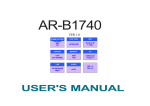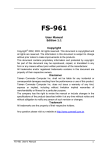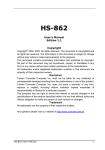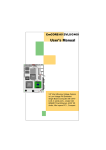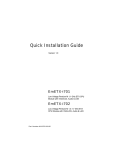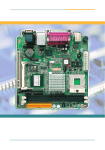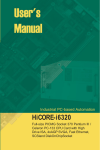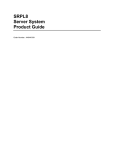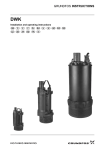Download USER`S MANUAL
Transcript
EmETX-i702 USER'S MANUAL Copyright 2005 Copyright 2005 CONTEC CO., LTD. ALL RIGHTS RESERVED INo part of this document may be copied or reproduced in any form by any means without prior written consent of CONTEC CO., LTD. CONTEC CO., LTD. makes no commitment to update or keep current the information contained in this document. The information in this document is subject to change without notice. All relevant issues have been considered in the preparation of this document. Should you notice an omission or any questionable item in this document, please feel free to notify CONTEC CO., LTD. Regardless of the foregoing statement, CONTEC assumes no responsibility for any errors that may appear in this document nor for results obtained by the user as a result of using this product. Trademarks Intel, Celeron and Pentium are registered trademarks of Intel Corporation. MS, Microsoft, Windows and Windows NT are trademarks of Microsoft Corporation. Other brand and product names are trademarks of their respective holder. All Other product names or trademarks are properties of their respective owners. EmETX-i702 User's Manual 2 Table of Contents Specifications Item Specifications ............................................................................. 3 CPU (Option) Specification Intel(R) Pentium(R) M Processor 1.6G - 2.0GHz (FSB 400MHz), PGA Intel(R) Celeron(R) M Processor 1.3G - 1.5GHz (FSB 400MHz), PGA Cache Built in CPU Processor socket Socket 479 Memory (Option) One 200-pin SO-DIMM socket, PC2100 DDR SDRAM for up to 1GB Chipset Intel(R) 852GM+ICH4 BIOS Award BIOS Board Dimension ........................................................................ 5 VGA Built in Intel(R) 815GME *1 Keyboard/Mouse connector One Keyboard , One Mouse *1 Jumper/Connector Quick Reference ......................................... 5 Serial I/F Board Layout Top View (Front) .................................................. 4 Board Layout Top View (Back) .................................................. 4 Two 16550 UART ports *1 Baud rate: 50 - 115,200bps (programmable) Parallel I/F One high-speed parallel port, support SPP/EPP/ECP mode *1 ETX Connector ............................................................................ 6 On board expansion bus Four PCI bus slots possibility are mounting on a base board. *1 LAN Port 100BASE-TX/10BASE-T, Intel ICH4 integrated controller *1 System Resources ...................................................................... 7 IDE I/F Two EIDE ports, up to four IDE devices, support Ultra DMA100 *1 SATA I/F None FDD I/F None Compact Flash Slot None SSD Socket None USB Port 4ch USB 2.0 complaint ports *1 IrDA IrDA 1.1 complaint port *1 RAID None Audio AC97 CODEC for speaker out, line in, CD Audio in, microphone in. *1 Watchdog Timer Software programmable 255 levels (1 - 255sec). Reset occurrence at the time of time up. General-purpose I/F None Hardware Monitor Monitoring of the temperature of CPU, power supply voltage, and fan speed AWARD BIOS Setup .................................................................... 9 Standard CMOS Setup ......................................................................................... 10 BIOS Features Setup ........................................................................................... 11 Chipset Features Setup ....................................................................................... 13 Integrated Peripherals ......................................................................................... 14 Super I/O Device .................................................................................................. 15 Power Management Setup .................................................................................. 16 PNP/PCI Configuration .......................................................................................... 17 PC Health Status .................................................................................................. 17 POST Codes .............................................................................. 18 RTC/CMOS *2 RTC/CMOS data backed up by Lithium battery The backup time of the Lithium battery is over 4 years at 25°C. The clock is accurate ±3 minutes/month at 25°C. (When using PBE-1000) Power Management Power management setup via BIOS Bus specification / Size (mm) None / 114(W) x 95(D) DC Power Requirements +5VDC ±5% Power supply specifications Pentium M 1.6GHz (Max.) +5VDC 7A Operating temperature / Operating Humidity 0 - 50°C /10 - 90%RH (No condensation) Storage temperature -30 - 85°C Floating dust particles Not to be excessive Corrosive gases None Weight 85g Operating System Support Windows XP Professional Windows 2000 Professional * 1 Wiring to the ETX connector and the connectors for the each devices, please mount them to the base board. *2 EmETX-i702 User's Manual When this product is equipped on the base board at first time, you have to clear CMOS. See PBE-1000 Quick Guide. 3 Board Layout Top View (Front) Board Layout Top View (Back) DDR SODIMM ETX4 ETX2 ETX3 ETX1 ICH4 CPU INTEL 855 GME EmETX-i702 User's Manual 4 Board Dimension Jumper/Connector Quick Reference Connectors Lable Function ETX1 PCI Bus, USB, Audio ETX2 ISA Bus ETX3 VGA,LCD,Video,COM1,COM2,LPT,IrDA,KB/MS ETX4 IDE1,IDE2,Ethernet,Miscellaneous UNIT: mm EmETX-i702 User's Manual 5 ETX Connector ETX1 1 3 5 7 9 11 13 15 17 19 21 23 25 27 29 31 33 35 37 39 41 43 45 47 49 51 53 55 57 59 61 63 65 67 69 71 73 75 77 79 81 83 85 87 89 91 93 95 97 99 GND PCICLK3 GND PCICLK1 REQ#3 GNT#2 REQ#2 REQ#1 GNT#0 VCC SERIRQ AD0 AD1 AD4 AD6 CBE#0 AD8 GND AD10 AD11 AD12 AD13 AD14 AD15 CBE#1 VCC PAR PERR# PME# LOCK# TRDY# IRDY# FRAME# GND AD16 AD17 AD19 AD20 AD22 AD23 AD24 VCC AD25 AD28 AD27 AD30 PCIRST# INTR#C INTR#A GND GND PCICLK4 GND PCICLK2 GNT#3 VCC3 GNT#1 VCC3 N.C VCC REQ#0 VCC3 AD2 AD3 AD5 AD7 AD9 GND AUXAL MIC AUXAR ASVCC SNDL ASGND SNDR VCC SERR# N.C USB2DEVSEL# USB3STOP# USB2+ GND CBE#2 USB3+ AD18 USB0AD21 USB1CBE#3 VCC AD26 USB0+ AD29 USB1+ AD31 INTR#D INTR#B GND EmETX-i702 User's Manual ETX2 2 4 6 8 10 12 14 16 18 20 22 24 26 28 30 32 34 36 38 40 42 44 46 48 50 52 54 56 58 60 62 64 66 68 70 72 74 76 78 80 82 84 86 88 90 92 94 96 98 100 1 3 5 7 9 11 13 15 17 19 21 23 25 27 29 31 33 35 37 39 41 43 45 47 49 51 53 55 57 59 61 63 65 67 69 71 73 75 77 79 81 83 85 87 89 91 93 95 97 99 GND PCICLK3 SD14 GND SD13 PCICLK1 SD12 REQ#3 SD11 GNT#2 SD10 REQ#2 SD9 REQ#1 SD8 GNT#0 MEMW# VCC MEMR# SERIRQ LA17 AD0 LA18 AD1 LA19 AD4 LA20 AD6 LA21 CBE#0 LA22 AD8 LA23 GND AD10 SBHE# AD11 SA0 AD12 SA1 AD13 SA2 AD14 SA3 AD15 SA4 CBE#1 SA5 VCC SA6 PAR PERR# SA7 PME# SA8 SA9 LOCK# TRDY# SA10 IRDY# SA11 SA12 FRAME# GND AD16 SA13 AD17 SA14 SA15 AD19 AD20 SA16 AD22 SA18 SA19 AD23 IOCHRDY AD24 VCC AD25 SD0 SD2 AD26 AD27 SD3 AD30 DREQ2 SD5 PCIRST# INTR#C SD6 INTR#A IOCHK# GND GND SD15 MASTER# DREQ7 DACK#7 DREQ6 DACK#6 DREQ5 DACK#5 DREQ0 DACK#0 IRQ14 IRQ15 IRQ12 IRQ11 IRQ10 IO16# GND M16# OSC BALE TC DACK#2 IRQ3 IRQ4 VCC IRQ5 IRQ6 IRQ7 SYSCLK REFCH# DREQ1 DACK#1 GND DREQ3 DACK#3 IOR# IOW# SA17 SMEMR# AEN VCC SMEMW# SD1 NOWS# SD4 IRQ9 SD7 RSTDRV GND ETX4 ETX3 2 4 6 8 10 12 14 16 18 20 22 24 26 28 30 32 34 36 38 40 42 44 46 48 50 52 54 56 58 60 62 64 66 68 70 72 74 76 78 80 82 84 86 88 90 92 94 96 98 100 1 3 5 7 9 11 13 15 17 19 21 23 25 27 29 31 33 35 37 39 41 43 45 47 49 51 53 55 57 59 61 63 65 67 69 71 73 75 77 79 81 83 85 87 89 91 93 95 97 99 GND R HSY VSY N.C/DE TX2CLK# TX2CLK+ GND TX2D1+ TX2D1# GND TX1D3# TX1D3+ GND TX1D2# TX1D2+ GND TX1D0+ TX1D0# VCC N.C. N.C BIASON N.C N.C N.C VCC STB# I.C IRRX IRTX RXD2 GND RTS#2 DTR#2 DCD#2 DSR#2 CTS#2 TXD#2 RI#2 VCC RXD1 RTS#1 DTR#1 DCD#1 DSR#1 CTS#1 TXD#1 RI#1 GND GND B G DDCK DDDA TX2D3# TX2D3+ GND TX2D2+ TX2D2# GND TX2D0+ TX2D0# GND TX1CLK+ TX1CLK# GND TX1D1+ TX1D1# VCC N.C BLON DIGON N.C N.C N.C GND AFD# PD7 ERR# PD6 INIT# GND PD5 SLIN# PD4 PD3 PD2 PD1 PD0 VCC ACK# BUSY# PE SLCT# MSCLK MSDAT KBCLK KBDAT GND 2 4 6 8 10 12 14 16 18 20 22 24 26 28 30 32 34 36 38 40 42 44 46 48 50 52 54 56 58 60 62 64 66 68 70 72 74 76 78 80 82 84 86 88 90 92 94 96 98 100 1 3 5 7 9 11 13 15 17 19 21 23 25 27 29 31 33 35 37 39 41 43 45 47 49 51 53 55 57 59 61 63 65 67 69 71 73 75 77 79 81 83 85 87 89 91 93 95 97 99 GND SV_SB PS_ON PWRBTN# N.C WDTOUT ROMKBCS# N.C VCC OVCR# EXTSMI# SMBCLK SIDE_CS3# SIDE_CS1# SIDE_A2 SIDE_A0 GND PD33/66 SEL SIDE_A1 SIDE_INTRQ SD33/66 SEL SIDE_ACK# SIDE_RDY SIDE_IOR# VCC SIDE_IOW# SIDE_DRQ SIDE_D15 SIDE_D0 SIDE_D14 SIDE_D1 SIDE_D13 GND SIDE_D2 SIDE_D12 SIDE_D3 SIDE_D11 SIDE_D4 SIDE_D10 SIDE_D5 VCC SIDE_D9 SIDE_D6 SIDE_D8 RING IN RXDRXD+ TXDTXD+ GND GND PWGIN SPEAKER BATT LILED ACTLED SPEEDLED 12CLK VCC GPCS# 12DAT SMBDAT CPUFAN DASP# PIDE_CS3# PIDE_CS1# GND PIDE_A2 PIDE_A0 PIDE_A1 N.C PIDE_INTRQ PIDE_ACK# PIDE_RDY VCC PIDE_IOR# PIDE_IOW# PIDE_DRQ PIDE_D15 PIDE_D0 PIDE_D14 PIDE_D1 GND PIDE_D13 PIDE_D2 PIDE_D12 PIDE_D3 PIDE_D11 PIDE_D4 PIDE_D10 VCC PIDE_D5 PIDE_D9 PIDE_D6 WOL PIDE_D8 SIDE_D7 PIDE_D7 HDRST# GND 2 4 6 8 10 12 14 16 18 20 22 24 26 28 30 32 34 36 38 40 42 44 46 48 50 52 54 56 58 60 62 64 66 68 70 72 74 76 78 80 82 84 86 88 90 92 94 96 98 100 6 System Resources Interrupt Request (IRQ) IRQ Address Description IRQ 00 System timer IRQ 01 Standard 101/102-Key or Microsoft Natural Keyboard IRQ 02 Programmable interrupt controller IRQ 03 Communications Port (COM2) IRQ 04 Communications Port (COM1) IRQ 05 PCI Multimedia Audio Device IRQ 05 PCI System Management Bus IRQ 05 IRQ Holder for PCI Steering IRQ 07 Printer Port (LPT1) IRQ 08 System CMOS/real time clock IRQ 09 PCI Universal Serial Bus IRQ 09 IRQ Holder for PCI Steering IRQ 0A Standard Universal PCI to USB Host Controller IRQ 0A Standard Universal PCI to USB Host Controller IRQ 0A IRQ Holder for PCI Steering IRQ 0A Standard PCI Graphics Adapter (VGA) IRQ 0B Intel(R) PRO/100 VE Network Connection IRQ 0B Standard Universal PCI to USB Host Controller IRQ 0B IRQ Holder for PCI Steering IRQ 0C PS/2 Compatible Mouse Port IRQ 0D Numeric data processor IRQ 0E Primary IDE controller (single fifo) IRQ 0E Standard Dual PCI IDE Controller IRQ 0F Secondary IDE controller (single fifo) IRQ 0F Standard Dual PCI IDE Controller Direct Memory Access (DMA) DMA Description 4 Direct memory access controller EmETX-i702 User's Manual Ports Input/Output (IO) I/O Address Description Memory 00000000-0009FFFF System board extension for PnP BIOS Memory 00000000-FFFFFFFF PCI standard PCI-to-PCI bridge Memory 00000000-FFFFFFFF PCI standard PCI-to-PCI bridge Memory 00000000-FFFFFFFF PCI standard PCI-to-PCI bridge Memory 000A0000-000AFFFF Standard PCI Graphics Adapter (VGA) Memory 000B0000-000BFFFF Standard PCI Graphics Adapter (VGA) Memory 000C0000-000CC7FF Standard PCI Graphics Adapter (VGA) Memory 000D8000-000D97FF Intel(R) PRO/100 VE Network Connection Memory 000D9800-000DBFFF Motherboard resources Memory 000F0000-000F3FFF Motherboard resources Memory 000F4000-000F7FFF Motherboard resources Memory 000F8000-000FFFFF Motherboard resources Memory 00100000-00FFFFFF System board extension for PnP BIOS Memory D0000000-D7FFFFFF Standard PCI Graphics Adapter (VGA) Memory D8000000-DFFFFFFF Standard PCI Graphics Adapter Memory E0000000-E3FFFFFF PCI standard host CPU bridge Memory E4000000-E4000FFF Intel(R) PRO/100 VE Network Connection Memory E4000000-E40FFFFF PCI standard PCI-to-PCI bridge Memory E4100000-E417FFFF Standard PCI Graphics Adapter Memory E4180000-E41FFFFF Standard PCI Graphics Adapter (VGA) Memory E4200000-E42003FF PCI Universal Serial Bus Memory E4201000-E42011FF PCI Multimedia Audio Device Memory E4202000-E42020FF PCI Multimedia Audio Device Memory FEC00000-FEC0FFFF System board extension for PnP BIOS Memory FEE00000-FEE0FFFF System board extension for PnP BIOS Memory FFB00000-FFB7FFFF System board extension for PnP BIOS Memory FFB80000-FFBFFFFF Unknown Device Memory FFF00000-FFFFFFFF System board extension for PnP BIOS Port 0000-FFFF PCI standard PCI-to-PCI bridge 7 Port 0020-0021 Programmable interrupt controller Port A400-A41F Standard Universal PCI to USB Host Controller Port 0040-0043 System timer Port A800-A81F Standard Universal PCI to USB Host Controller Port 0060-0060 Standard 101/102-Key or Microsoft Natural Keyboard Port AC00-AC07 Standard PCI Graphics Adapter (VGA) Port 0061-0061 System speaker Port B400-B4FF PCI Multimedia Audio Device Port 0070-0071 System CMOS/real time clock Port B800-B83F PCI Multimedia Audio Device Direct memory access controller Port F000-F007 Primary IDE controller (single fifo) Port 0087-0087 Direct memory access controller Port F000-F00F Standard Dual PCI IDE Controller Port 0089-008B Direct memory access controller Port F008-F00F Secondary IDE controller (single fifo) Port 008F-0091 Direct memory access controller Port 00A0-00A1 Programmable interrupt controller Port 00C0-00DF Direct memory access controller Port 00F0-00FF Numeric data processor Port 0170-0177 Secondary IDE controller (single fifo) Port 0170-0177 Standard Dual PCI IDE Controller Port 01F0-01F7 Primary IDE controller (single fifo) Port 01F0-01F7 Standard Dual PCI IDE Controller Port 02F8-02FF Communications Port (COM2) Port 0376-0376 Secondary IDE controller (single fifo) Port 0376-0376 Standard Dual PCI IDE Controller Port 0378-037F Printer Port (LPT1) Port 03B0-03BB Standard PCI Graphics Adapter (VGA) Port 03C0-03DF Standard PCI Graphics Adapter (VGA) Port 03F6-03F6 Primary IDE controller (single fifo) Port 03F6-03F6 Standard Dual PCI IDE Controller Port 03F8-03FF Communications Port (COM1) Port 0400-04BF PCI bus Port 04D0-04D1 PCI bus Port 0500-051F PCI System Management Bus Port 0778-077B Printer Port (LPT1) Port 0CF8-0CFF PCI bus Port 9000-903F Intel(R) PRO/100 VE Network Connection Port 9000-9FFF PCI standard PCI-to-PCI bridge Port A000-A01F Standard Universal PCI to USB Host Controller Port 0081-0083 EmETX-i702 User's Manual 8 AWARD BIOS Setup The EmETX-i702 uses the Award PCI/ISA BIOS for the system configuration. The Award BIOS setup program is designed to provide the maximum flexibility in configuring the system by offering various options which could be selected for enduser requirements. This chapter is written to assist you in the proper usage of these features. To access AWARD PCI/ISA BIOS Setup program, press <Del> key. The Main Menu will be displayed at this time. Setup Items The main menu includes the following main setup categories. Recall that some systems may not include all entries. Standard CMOS Features Use this menu for basic system configuration. Advanced BIOS Features Use this menu to set the Advanced Features available on your system. Advanced Chipset Features Use this menu to change the values in the chipset registers and optimize your system's performance. Integrated Peripherals Use this menu to specify your settings for integrated peripherals. Power Management Setup Use this menu to specify your settings for power management. PnP / PCI Configuration This entry appears if your system supports PnP / PCI. PC Health Status This entry helps you to monitor the status of PC. Load Optimized Defaults Use this menu to load the BIOS default values that are factory settings for optimal performance system operations. W hile Award has designed the custom BIOS to maximize performance, the factory has the right to change these defaults to meet their needs. Set Password Use this menu to set User and Supervisor Passwords. Once you enter the AwardBIOS™ CMOS Setup Utility, the Main Menu will appear on the screen. The Main Menu allows you to select from several setup functions and two exit choices. Use the arrow keys to select among the items and press <Enter> to accept and enter the sub-menu. EmETX-i702 User's Manual Save & Exit Setup Save CMOS value changes to CMOS and exit setup. Exit Without Save Abandon all CMOS value changes and exit setup. 9 Standard CMOS Setup Video Select the type of primary video subsystem in your computer. The BIOS usually detects the correct video type automatically. The BIOS supports a secondary video subsystem, but you do not select it in Setup. Halt On During the power-on self-test (POST), the computer stops if the BIOS detects a hardware error. You can tell the BIOS to ignore certain errors during POST and continue the boot-up process. These are the selections: No errors POST does not stop for any errors. All errors If the BIOS detects any non-fatal error, POST stops and prompts you to take corrective action. All, But Keyboard POST does not stop for a keyboard error, but stops for all other errors. All, But Diskette POST does not stop for diskette drive errors, but stops for all other errors. All, But Disk/Key POST does not stop for a keyboard or disk error, but stops for all other errors. Date The BIOS determines the day of the week from the other date information; this field is for information only. Time The time format is based on the 24-hour military-time clock. For example, 1 p.m. is 13:00:00. Press the « or ( key to move to the desired field . Press the PgUp or PgDn key to increment the setting, or type the desired value into the field. IDE Primary Master/Slave IDE Secondary Master/Slave Options are in sub menu (see page 30) Drive A, B Select the correct specifications for the diskette drive(s) installed in the computer. None : No diskette drive installed 360K ; 5.25 in 5-1/4 inch PC-type standard drive 1.2M ; 5.25 in 5-1/4 inch AT-type high-density drive 720K ; 3.5 in 3-1/2 inch double-sided drive 1.44M ; 3.5 in 3-1/2 inch double-sided drive 2.88M ; 3.5 in 3-1/2 inch double-sided drive EmETX-i702 User's Manual 10 BIOS Features Setup CPU L1 & L2 Cache This item allows you to enable/disable CPU L1 & L2 Cache. The choice: Enabled, Disabled. CPU L3 Cache This item allows you to enable/disable CPU L3 Cache. The choice: Enabled, Disabled. Quick Power On Self Test This category speeds up Power On Self Test (POST) after you power up the computer. If it is set to Enable, BIOS will shorten or skip some check items during POST. Enabled : Enable quick POST. Disabled : Normal POST First/Second/Third Boot Device The BIOS attempts to load the operating system from the devices in the sequence selected in these items. The choices are : Floppy, LS/ZIP, HDD, SCSI, CDROM, Disabled. Swap Floppy Drive If the system has two floppy drives, you can swap the logical drive name assignments. The choice: Enabled/Disabled. Boot Up Floppy Seek Seeks disk drives during boot up. Disabling speeds boot up. The choice: Enabled/Disabled. Virus Warning Allows you to choose the VIRUS Warning feature for IDE Hard Disk boot sector protection. If this function is enabled and someone attempt to write data into this area, BIOS will show a warning message on screen and beep. Enabled Activates automatically when the system boots up causing a warning message to appear when anything attempts to access the boot sector or hard disk partition table. Disabled No warning message will appear when anything attempts to access the boot sector or hard disk partition table. EmETX-i702 User's Manual Boot Up NumLock Status Select power on state for NumLock. The choice: Enabled/Disabled. Gate A20 Option Select if chipset or keyboard controller should control GateA20. Normal A pin in the keyboard controller controls GateA20 Fast Lets chipset control GateA20 Typematic Rate Setting Key strokes repeat at a rate determined by the keyboard controller. When enabled, the typematic rate and typematic delay can be selected. The choice: Enabled/Disabled. 11 Security Option Select whether the password is required every time the system boots or only when you enter setup. 'Memory'. This will tell you what segments (if any) are being shadowed For DOS you can use MSD.EXE to see what segments are claimed. CC000-CFFFF - D0000-D3FFF - D4000-D7FFF - D8000-DBFFF and DC000-DFFFF - Same as above. System The system will not boot and access to Setup will be denied if the correct password is not entered at the prompt. Setup The system will boot, but access to Setup will be denied if the correct password is not entered at the prompt. Note To disable security, select PASSWORD SETTING at Main Menu and then you will be asked to enter password. Do not type anything and just press <Enter>, it will disable security. Once the security is disabled, the system will boot and you can enter Setup freely. APIC Mode Select OS Select For DRAM > 64MB Select the operating system that is running with greater than 64MB of RAM on the system.The choice: Non-OS2, OS2. Video BIOS Shadow Enabled this copies the video BIOS from ROM to RAM. effectively enhancing performance, and reducing the amount of upper memory available by 32KB (the C0000~C7FFF area of memory between 640 KB and 1 MB is used). C8000-CBFFF Shadow Enabling any of the C8000~CBFFF segments allows components to move their firmware into these upper memory segments. However your computer can lock-up doing so, because some devices don't like being shadowed at those particular 16 KB segments of upper memory. Small Logo(EPA) Show [Enabled]: If you want to show your logo, please enable it. [Disabled]: When this item disabled, logo(EPA) will not show on screen. EEPROM Write Protect All the configuration data is stored in a type of nonvolatile memor chip called an EEPROM. When it's enabled, it disables all writes to the configuration EEPROM. This locks your current configuration against accidenatal or unauthorized changes. Note - In W indows 95, double click 'Computer' within Device Manager and select EmETX-i702 User's Manual 12 Chipset Features Setup DRAM Data Integrity Mode This BIOS feature controls the ECC feature of the memory controller. The option is ECC or Non-ECC. MGM Core Frequency The option includes 400/266/133/200 MHz. System BIOS Cacheable Selecting Enabled allows caching of the system BIOS ROM at F0000h-FFFFFh, resulting in better system performance. However, if any program writes to this memory area, a system error may result. Video BIOS Cacheable Select Enabled allows caching of the video BIOS, resulting in better system performance. However, if any program writes to this memory area, a system error may result. DRAM Timing Selectable The option is "Manual" or "by SPD. CAS Latency Time When synchronous DRAM is installed, the number of clock cycles of CAS latency depends on the DRAM timing. Memory Hole At 15M-16M You can reserve this area of system memory for ISA adapter ROM. When this area is reserved, it cannot be cached. The user information of peripherals that need to use this area of system memory usually discusses their memory requirement. Delayed Transaction The chipset has an embedded 32-bit posted write buffer to support delay transactions cycles. Select Enabled to support compliance with PCI specification version 2.1 Delay Prior to Thermal Active to Precharge Delay Delay that results when two different rows in a memory chip are addressed one after another. DRAM RAS-to-CAS Delay This field let's you insert a timing delay between the CAS and RAS strobe signals, used when DRAM is written to, read from, or refreshed. Fast gives faster performance; and Slow gives more stable performance. This field applies only when synchronous DRAM is installed in the system. DRAM RAS Precharge If an insufficient number of cycles is allowed for the RAS to accumulate its charge before DRAM refresh, the refresh may be incomplete and the DRAM may fail to retain data. Fast gives faster performance; and Slow givesmore stable performance. This field applies only when synchronous DRAM is installed in the system. EmETX-i702 User's Manual This BIOS feature is only valid for systems that are powered by 0.13£g Intel Pentium 4 processors with 512KB L2 cache. These processors come with a Thermal Monitor which actually consists of a on-die thermal sensor and a Thermal Control Circuit (TCC). The options includes 4 Minutes, 8 Minutes, 16 Minutes, 32. AGP Aperture Size This fielf determines the effective size of the Graphic Aperture used for a particular GMCH configuration. It can be updated by the GMCH-specific BIOS configuration sequence before the PCI standard bus enumeration sequence takes place. If it is not updated then a default value will select an aperture of maximum size. On-Chip VGA If your system contains a VGA controller and you want to activate it, select Enabled. The next option will become available. 13 On-Chip Frame Buffer Size Integrated Peripherals The On-Chip Frame Buffer Size can be set to 1MB or 8MB. This memory is shared with system memory. Boot Display This option let you select the display devices. Panel Number This option let you select the type of panel. Available options are: 640 x 480 18bit 800 x 600 18bit 1024 x 768 18bit 1280 x 1024 18bit 1400 x 1050 18bit 2H (Reduced Blanking LVDS) 1400 x 1050 18bit 2H (Non-reduced Blanking LVDS) 1600 x 1200 18bit 2H 1024 x 768 24bit 1280 x 1024 24bit 2H 1400 x 1050 24bit 2H Onboard Device This field let you set onboard devices. 1600 x 1200 24bit 2H Super I/O Device OnChip IDE Device The integrated peripheral controller contains an IDE interface with support for two IDE channels. Select Enabled to activate each channel separately. >Onboard LAN Boot ROM The default setting is "Disabled" that to shorten the booting time. EmETX-i702 User's Manual 14 Super I/O Device IR Transmission Delay This option is to set whether the IR Transmission Delay is enabled. The available setting values are Disabled and Enabled. IR2 Duplex Mode This item allows you to select the IR half/full duplex function. Use IR Pins This item allows you to select IR transmission routes, IR-Rx2Tx2, RxD2 and TxD2. Onboard Parallel Port Select the interrup of Parallel Port. Onboard Parallel Mode Select an operating mode for the parallel port. Mode options are 3BC/IRQ7, 378/IRQ7, 278/IRQ5, and Disable. External FDC Controller EPP Mode Select You can use this feature to choose which version of EPP to use. For better performance, use EPP 1.9. But if you are facing connection issues, try setting it to EPP 1.7. Most of the time, EPP 1.9 will work perfectly well. Select "Enabled" to activate the on-board FDD Select "Disabled" to activate an add-on FDD ECP Mode Use DMA Select a DMA channel if parallel Mode for using ECP mode: 3 or 1. Onboard Serial Port 1 & 2 Select an address and corresponding interrupt for the first/second serial port. The default value for the first serial port is "3F8/IRQ4" and the second serial port is "2F8/ IRQ3". Secondary I/O Controller This item let you disable or enable Secondary I/O Controller. UART Mode Select This item allows you to select UART mode. The choices: IrDA, ASKIR, Normal. RxD, TxD Active This BIOS feature allows you to set the infra-red reception (RxD) and transmission (TxD) polarity. Common Options : Hi, Hi or Lo, Lo or Hi, Lo or Lo, Hi EmETX-i702 User's Manual 15 Power Management Setup V/H SYNC+Blank cause the system to turn off the vertical and horizontal synchronization signals and writes blanks to the screen. Blank Screen This option only writes blanks to the screen. DPMS Initial display power management signaling.HDD Power Down is always set independently Video Off In Suspend Controls what causes the display to be switched off Suspend -> Off Always On All Mode -> Off Suspend Type S1 (POS) Power On suspend All devices are powered up except for the clock synthesizer. The Host and PCI clocks are inactive and PIIX4 provides control signals and 32-kHz Suspend Clock (SUSCLK) to allow for DRAM refresh and to turn off the clock synthesizer. The only power consumed in the system is due to DRAM Refresh and leakage current of the powered devices. When the system resumes from POS, PIIX4 can optionally resume without resetting the system, can reset the processor only, or can reset the entire system. When no reset is performed, PIIX4 only needs to wait for the clock synthesizer and processor PLLs to lock before the system is resumed. This takes typically 20 ms. Power Supply Type Select the power supply type. Power Management There are 4 selections for Power Management, 3 of which have fixed mode : S3 (STR) Suspend To RAM Power is removed from most of the system components during STR, except the DRAM. Power is supplied to Suspend Refresh logic in the Host Controller, and RTC and Suspend Well logic in PIIX4. PIIX4 provides control signals and 32-kHz Suspend Clock (SUSCLK) to allow for DRAM refresh and to turn off the clock synthesizer and other power planes. Disabled (default) No power management. Disables all four modes. Min. Power Saving Minimum power management. Doze Mode = 1 hr., Standby Mode = 1 hr., Suspend Mode = 1 hr., Modem Use IRQ Name the interrupt request (IRQ) assigned to the modem (if any) on your system. Activity of the selected IRQ always awakens the system. Max. Power Saving Maximum power management -- ONLY AVAILABLE FOR SL CPU's.. Doze Mode = 1 min., Standby Mode = 1 min., Suspend Mode = 1 min. Suspend Mode When the suspend mode has been enabled after the selected period of system inactivity, all devices except CPU will be shut down. User Defined Allows you to set each mode individually. When not disabled, each of the ranges are from 1 min. to 1 hr. CPU THRM-Throtting Video Off Method This determines the manner in which the monitor is blanked. EmETX-i702 User's Manual This BIOS feature determines the clock speed of the processor when it is in the Suspend To RAM (STR) power saving mode. It has no effect when the processor is in normal active mode. Available options for this BIOS feature are set values of the processor's power consumption. They range from a low of 12.5% to a high of 87.5%. 16 PNP/PCI Configuration PC Health Status This section describes configuring the PCI bus system. PCI, or Personal Computer Interconnect, is a system which allows I/O devices to operate at speeds nearing the speed the CPU itself uses when communicating with its own special components. This section describes CPU tempeare for the system. Reset Configuration Data Normally, you leave this field Disabled. Select Enabled to reset ESCD (Extended System Configuration Date) when you exit Setup if you have installed a new add-on and the system reconfiguration has caused such a serious conflict that the operating system cannot boot. Shutdown Temperature This item allows you to set up the CPU shutdowm Temperature. This item only effective under Windows 98 ACPI mode. Resource Controlled By The Award Play and Play BIOS can automatically configure all the boot and Plug-andPlay compatible devices. If you select Auto, all the interrupt request (IRQ) and DMA assignment fields disappear, as the BIOS automatically assigns them. PCI/VGA Palette Snoop Normally this option is always Disabled! Nonstandard VGA display adapters such as overlay cards or MPEG video cards may not show colors properly. Setting Enabled should correct this problem. If this field set Enabled, any I/O access on the ISA bus to the VGA card's palette registers will be reflected on the PCI bus. This will allow overlay cards to adapt to the changing palette colors. PCI IRQ Actived by [Level] EmETX-i702 User's Manual 17 POST Codes 0Ah The following codes are not displayed on the screen. They can only be viewed on the LED display of a so called POST card. The codes are listened in the same order as the according functions are executed at PC startup. If you have access to a POST Card reader, you can watch the system perform each test by the value that's displayed. If the system hangs (if there's a problem) the last value displayed will give you a good idea where and what went wrong, or what's bad on the system board. 1. Disable PS/2 mouse interface (optional). 2. Auto detect ports for keyboard & mouse followed by a port & interface swap (optional). 3. Reset keyboard for Winbond 977 series Super I/O chips. 0Bh Reserved 0Ch Reserved 0Dh Reserved CODE DESCRIPTION OF CHECK 0Eh CFh Test CMOS R/W functionality. Test F000h segment shadow to see whether it is R/W-able or not. If test fails, keep beeping the speaker. C0h Early chipset initialization: -Disable shadow RAM -Disable L2 cache (socket 7 or below) -Program basic chipset registers C1h Detect memory -Auto-detection of DRAM size, type and ECC. -Auto-detection of L2 cache (socket 7 or below) 0Fh Reserved 10h Auto detect flash type to load appropriate flash R/W codes into the run time area in F000 for ESCD & DMI support. 11h Reserved 12h Use walking 1's algorithm to check out interface in CMOS circuitry. Also set real-time clock power status, and then check for override. C3h Expand compressed BIOS code to DRAM 13h Reserved C5h Call chipset hook to copy BIOS back to E000 & F000 shadow RAM. 14h Program chipset default values into chipset. Chipset default values are MODBINable by OEM customers. 0h1 Expand the Xgroup codes locating in physical address 1000:0 15h Reserved 02h Reserved 16h 03h Initial Superio_Early_Init switch. Initial onboard clock generator if Early_Init_Onboard_Generator is defined. See also POST 26h. 04h Reserved 17h Reserved 05h 1. Blank out screen 2. Clear CMOS error flag 18h Detect CPU information including brand, SMI type (Cyrix or Intel) and CPU level (586 or 686). 06h Reserved 19h Reserved 07h 1. Clear 8042 interface 2. Initialize 8042 self-test 1Ah Reserved 1Bh 1. Test special keyboard controller for Winbond 977 series Super I/O chips. 2. Enable keyboard interface. Initial interrupts vector table. If no special specified, all H/W interrupts are directed to SPURIOUS_INT_HDLR & S/W interrupts to SPURIOUS_soft_HDLR. 1Ch Reserved Reserved 1Dh Initial EARLY_PM_INIT switch. 08h 09h EmETX-i702 User's Manual 18 CPU type, CPU speed, full screen logo. 1Eh Reserved 1Fh Load keyboard matrix (notebook platform) 2Eh Reserved 20h Reserved 2Fh Reserved 21h HPM initialization (notebook platform) 30h Reserved 22h Reserved 31h Reserved 23h 1. Check validity of RTC value: e.g. a value of 5Ah is an invalid value for RTC minute. 2. Load CMOS settings into BIOS stack. If CMOS checksum fails, use default value instead. 32h Reserved 33h Reset keyboard if Early_Reset_KB is defined e.g. Winbond 977 series Super I/O chips. See also POST 63h. 34h Reserved 35h Test DMA Channel 0 36h Reserved 37h Test DMA Channel 1. 38h Reserved 39h Test DMA page registers. 3Ah Reserved 3Bh Reserved 24h Prepare BIOS resource map for PCI & PnP use. If ESCD is valid, take into consideration of the ESCD's legacy information. 25h Early PCI Initialization: -Enumerate PCI bus number. -Assign memory & I/O resource -Search for a valid VGA device & VGA BIOS, and put it into C000:0 26h 1. If Early_Init_Onboard_Generator is not defined Onboard clock generator initialization. Disable respective clock resource to empty PCI & DIMM slots. 2. Init onboard PWM 3. Init onboard H/W monitor devices 3Ch Test 8254 27h Initialize INT 09 buffer 3Dh Reserved 28h Reserved 3Eh Test 8259 interrupt mask bits for channel 1. 29h 1. Program CPU internal MTRR (P6 & PII) for 0-640K memory address. 2. Initialize the APIC for Pentium class CPU. 3. Program early chipset according to CMOS setup. Example: onboard IDE controller. 4. Measure CPU speed. 3Fh Reserved 40h Test 8259 interrupt mask bits for channel 2. 41h Reserved 42h Reserved 2Ah Reserved 43h Test 8259 functionality. 2Bh Invoke Video BIOS 44h Reserved 2Ch Reserved 45h Reserved 2Dh 1. Initialize double-byte language font (Optional) 2. Put information on screen display, including Award title, 46h Reserved 47h Initialize EISA slot EmETX-i702 User's Manual 19 48h Reserved 5Ch Reserved 49h 1. Calculate total memory by testing the last double word of each 64K page. 2. Program write allocation for AMD K5 CPU. 5Dh 1. Initialize Init_Onboard_Super_IO 2. Initialize Init_Onbaord_AUDIO. 5Eh Reserved 4Ah Reserved 5Fh Reserved 4Bh Reserved 60h 4Ch Reserved Okay to enter Setup utility; i.e. not until this POST stage can users enter the CMOS setup utility. 4Dh Reserved 61h Reserved 4Eh 1. Program MTRR of M1 CPU 2. Initialize L2 cache for P6 class CPU & program CPU with proper cacheable range. 3. Initialize the APIC for P6 class CPU. 4. On MP platform, adjust the cacheable range to smaller one in case the cacheable ranges between each CPU are not identical. 62h Reserved 63h Reset keyboard if Early_Reset_KB is not defined. 64h Reserved 65h Initialize PS/2 Mouse 66h Reserved 4Fh Reserved 67h 50h Initialize USB Keyboard & Mouse. Prepare memory size information for function call: INT 15h ax=E820h 51h Reserved 68h Reserved 52h Test all memory (clear all extended memory to 0) 69h Turn on L2 cache 53h Clear password according to H/W jumper (Optional) 6Ah Reserved 54h Reserved 6Bh Program chipset registers according to items described in Setup & Autoconfiguration table. 55h Display number of processors (multi-processor platform) 6Ch Reserved 56h Reserved 6Dh 57h 1. Display PnP logo 2. Early ISA PnP initialization -Assign CSN to every ISA PnP device. 1. Assign resources to all ISA PnP devices. 2. Auto assign ports to onboard COM ports if the corresponding item in Setup is set to "AUTO". 6Eh Reserved 58h Reserved 6Fh 59h Initialize the combined Trend Anti-Virus code. 1. Initialize floppy controller 2. Set up floppy related fields in 40:hardware. 5Ah Reserved 70h Reserved 5Bh (Optional Feature) Show message for entering AWDFLASH.EXE from FDD (optional) 71h Reserved 72h Reserved EmETX-i702 User's Manual 20 73h (Reserved 86h Reserved 74h Reserved 87h NET PC: Build SYSID Structure. 75h Detect & install all IDE devices: HDD, LS120, ZIP, CDROM….. 88h Reserved 76h (Optional Feature) Enter AWDFLASH.EXE if: -AWDFLASH.EXE is found in floppy drive. -ALT+F2 is pressed. 89h 1. Assign IRQs to PCI devices 2. Set up ACPI table at top of the memory. 8Ah Reserved 77h Detect serial ports & parallel ports. 8Bh 1. Invoke all ISA adapter ROMs 2. Invoke all PCI ROMs (except VGA) 78h Reserved 8Ch Reserved 79h Reserved 8Dh 7Ah Detect & install co-processor 1. Enable/Disable Parity Check according to CMOS setup 2. APM Initialization 7Bh Reserved 8Eh Reserved 7Ch Init HDD write protect. 8Fh Clear noise of IRQs 7Dh Reserved 90h Reserved 7Eh Reserved 91h Reserved 7Fh Switch back to text mode if full screen logo is supported. - If errors occur, report errors & wait for keys - If no errors occur or F1 key is pressed to continue : wClear EPA or customization logo. 92h Reserved 93h Read HDD boot sector information for Trend Anti-Virus code 94h 1. 2. 3. 4. 5. 6. 7. 8. 95h Update keyboard LED & typematic rate 96h 1. 2. 3. 4. 5. FFh Boot attempt (INT 19h) 80h Reserved 81h Reserved E8POST.ASM starts 82h 1. Call chipset power management hook. 2. Recover the text fond used by EPA logo (not for full screen logo) 3. If password is set, ask for password. 83h Save all data in stack back to CMOS 84h Initialize ISA PnP boot devices 85h 1. USB final Initialization 2. Switch screen back to text mode EmETX-i702 User's Manual Enable L2 cache Program Daylight Saving Program boot up speed Chipset final initialization. Power management final initialization Clear screen & display summary table Program K6 write allocation Program P6 class write combining Build MP table Build & update ESCD Set CMOS century to 20h or 19h Load CMOS time into DOS timer tick Build MSIRQ routing table. 21























